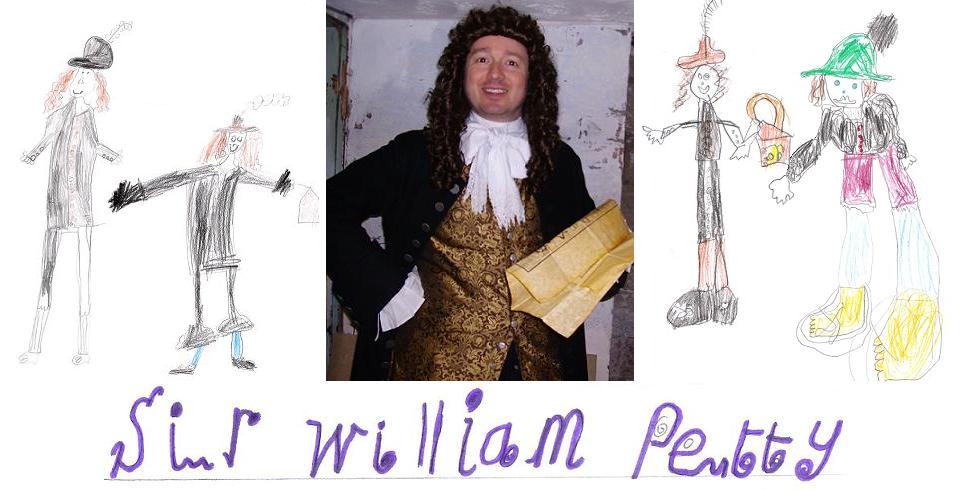For Key Stages 1 or 2
 Sir William Petty was a mathematician and member of the Royal Society who knows a lot of people, including the King and Samuel Pepys. He suffered lost properties in the fire, costing him four thousand pounds, then carefully studied the consequences of the Great Fire and drew up outline plans for what ought to be done afterwards. To your children he is a friendly and eccentric fellow with lots of stories to tell. (I know children remember the experience for years afterwards because UKS2 children will call me by name with a smile on their faces even though I met them four years earlier!)
Sir William Petty was a mathematician and member of the Royal Society who knows a lot of people, including the King and Samuel Pepys. He suffered lost properties in the fire, costing him four thousand pounds, then carefully studied the consequences of the Great Fire and drew up outline plans for what ought to be done afterwards. To your children he is a friendly and eccentric fellow with lots of stories to tell. (I know children remember the experience for years afterwards because UKS2 children will call me by name with a smile on their faces even though I met them four years earlier!)
If there are two classes studying the fire, then I can do a session with each (morning and afternoon). I even have ways of working with three or four classes. Having a whole day with one class, however, allows me to do that bit more.
When should Sir William visit?
The session works well whether or not the children already know about the Great Fire. If the session introduces the topic, then I can give them all a shared and rich experience to refer back to throughout their subsequent work. If it is the end of their study, I can conversationally explore and add to their existing knowledge, bringing it all ‘to life’. If I visit in the middle of your topic, then a bit of both applies, and the day provides an exciting boost to their knowledge and enthusiasm!
Find out More...
Survive the Great Fire!
Session Format
Introductions
|
The Story of the FireThis is the main component of the session and incorporates several breaks along the way to do practical exercises.
|
After the FireI can discuss with the children a whole range of things. Like who got the blame and should people have known there would be a fire? Also the deaths and difficulties caused, and what needed doing after the fire. When I work with one class all day I can also tell the story of Robert Hubert and the trouble he got himself into by lying. |
Some Work for Sir WilliamI can begin this work with the class if I am working with one class all day. If it is a two class day with half the day with each class, then I can set one of these tasks for the class to do later. The options are: A design for the New London. The children work on different little parts of London (wards and parishes) each, which when joined together makes one giant map for a wall display – a map they have all been involved creating. This involves not just History but also Art and Geography. This is the work that nearly every teacher in 15 years has chosen. Posters with instructions about the new London.
A portrait of a gentleman When I work with one class for the whole day, I can admit to some jealousy over Samuel Pepys’ portraits and ask the class if they might sketch a portrait of me, posing for them to do so. This way they notice the details of my late 1660’s fashions, as well as doing some art work as a lovely way to end the day. |
Find out More...
Survive the Great Fire!
“Thank you for an amazing day! You certainly brought our topic of the Great Fire of London to life. The children were totally captivated and keen to take part. We have thoroughly enjoyed an action packed day.”
“The children gained so much from your visit and lots of parents commented on the knowledge the children had about the Great Fire of London after you had visited.”
“Sir William Petty. A fantastic morning which held our pupils’ attention. It really had the Wow factor! Many thanks.”
“Thank you for another super day learning about the Great Fire of London. The children have loved the day and have been involved in all the activities and asked a range of interesting questions – which I am sure will continue tomorrow!”
“We had a brilliant day. History came to life. The children were fascinated and wanted Sir William to stay for the week.”
“What a great day! It was Sir William Petty’s first visit to our school but hopefully not the last. The children thoroughly enjoyed the experience and it certainly brought the Great Fire of London to life. Thank you very much.”


